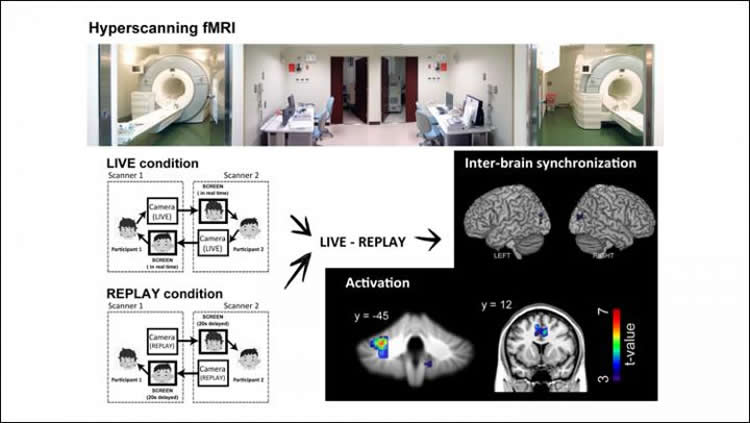Summary: A new neuroimaging study reveals real time eye contact is a basis for effective social communication. The study found eye contact between two people simultaneously activated the same areas of each person’s brain.
Source: SfN.
Eye contact between two individuals simultaneously activates the same areas of each person’s brain, according to a neuroimaging study of human adult pairs published in eNeuro. The research emphasizes real-time eye contact as the basis for effective social interaction.
Norihiro Sadato and colleagues used a technique called hyperscanning functional magnetic resonance (fMRI) imaging to observe two people as they gazed into their partner’s eyes. A video camera and screen in each person’s fMRI scanner allowed the researchers to compare brain activity during this social task in real-time or with a 20-second delay.

The live condition was associated with a mutual influence between the partners’ eye-blinks, increased activation of the cerebellum, and enhanced connectivity within the limbic mirror system. These behavioral and neural findings suggest real-time eye contact prepares the social brain for sharing mental states with others. This study also represents an advance over previous eye-contact research involving single participants.
Funding: Japan Society for the Promotion of Science, Ministry of Education, Culture, Sports, Science and Technology, Japan Agency for Medical Research and Development, HAYAO NAKAYAMA Foundation for Science & Technology and Culture funded this study.
Source: David Barnstone – SfN
Publisher: Organized by NeuroscienceNews.com.
Image Source: NeuroscienceNews.com image is credited to Koike et al., eNeuro (2019)
Original Research: Abstract for “What makes eye contact special? Neural substrates of on-line mutual eye-gaze: a hyperscanning fMRI study” by Takahiko Koike, Motofumi Sumiya, Eri Nakagawa, Shuntaro Okazaki and Norihiro Sadato in eNeuro. Published February 25 2019.
doi:10.1523/ENEURO.0284-18.2019
[cbtabs][cbtab title=”MLA”]SfN “Eye Contact Prepares Brains for Social Interaction.” NeuroscienceNews. NeuroscienceNews, 25 February 2019.
<https://neurosciencenews.com/eye-contact-social-interaction-10808/>.[/cbtab][cbtab title=”APA”]SfN (2019, February 25). Eye Contact Prepares Brains for Social Interaction. NeuroscienceNews. Retrieved February 25, 2019 from https://neurosciencenews.com/eye-contact-social-interaction-10808/[/cbtab][cbtab title=”Chicago”]SfN “Eye Contact Prepares Brains for Social Interaction.” https://neurosciencenews.com/eye-contact-social-interaction-10808/ (accessed February 25, 2019).[/cbtab][/cbtabs]
Abstract
What makes eye contact special? Neural substrates of on-line mutual eye-gaze: a hyperscanning fMRI study
Automatic mimicry is a critical element of social interaction. A salient type of automatic mimicry is eye contact characterized by sharing of affective and mental states among individuals. We conducted a hyperscanning functional magnetic resonance imaging (fMRI) study involving online (LIVE) and delayed off-line (REPLAY) conditions to test our hypothesis that recurrent interaction through eye contact activates the limbic mirror system, including the anterior cingulate cortex (ACC) and anterior insula (AIC), both of which are critical for self-awareness. Sixteen pairs of human adults participated in the experiment. Given that an eye-blink represents an individual’s attentional window toward the partner, we analyzed pairwise time-series data for eye-blinks. We used multivariate autoregression analysis to calculate the noise contribution ratio (NCR) as an index of how a participant’s directional attention was influenced by that of their partner. NCR was greater in the LIVE than in the REPLAY condition, indicating mutual perceptual–motor interaction during real-time eye contact. Relative to the REPLAY condition, the LIVE condition was associated with greater activation in the left cerebellar hemisphere, vermis, and ACC, accompanied by enhanced functional connectivity between ACC and right AIC. Given the roles of the cerebellum in sensorimotor prediction and ACC in movement initiation, ACC–cerebellar activation may represent their involvement in modulating visual input related to the partner’s movement, which may, in turn, involve the limbic mirror system. Our findings indicate that mutual interaction during eye contact is mediated by the cerebellum and limbic mirror system.
Significance Statement
Eye contact is a key element that connects humans during social communication. We focused on a previously unaddressed characteristic of eye contact: real-time mutual interaction as a form of automatic mimicry. Our results indicate that real-time interaction during eye contact is mediated by the cerebellum and limbic mirror system. These findings underscore the importance of the mirror system and cerebellum in real-time unconscious social interaction.






